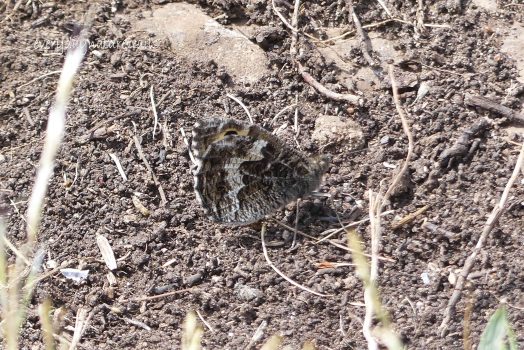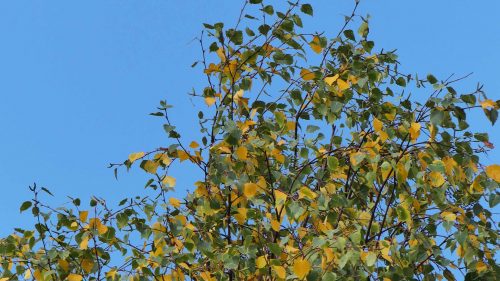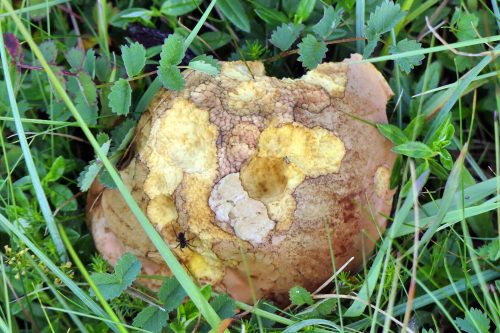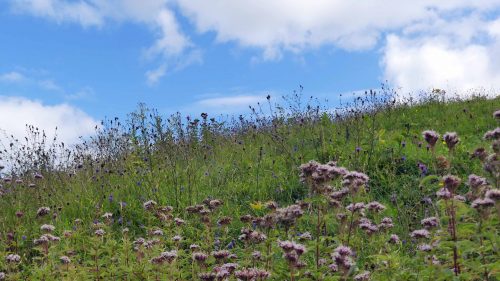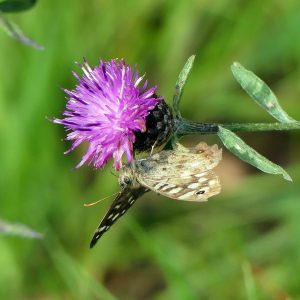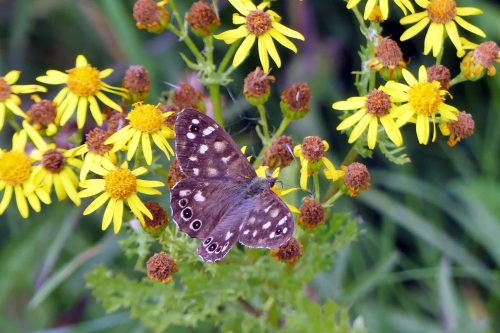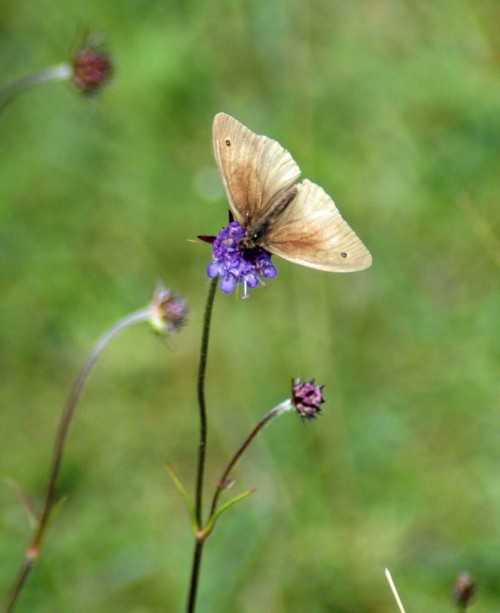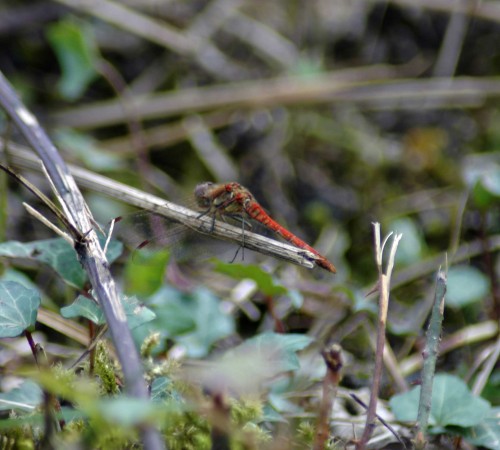Tags
6-spot Burnet Moth, Arge pagana, Bryn Euryn Nature Reserve, calcareous grassland, Cinnabar moth, Cistus Forester moth, common spotted orchid, dark green fritillary, grayling, Large Skipper, Meadow Brown, Painted Lady, Ringlet, rose sawfly, scabious, silver y moth, slow walking, slow worm, small heath, small tortoiseshell
Emerging from the shelter of the Woodland….
12:05 The steps lead up from the Woodland Trail and into an open sloping grassy space, whose character changes from year to year, largely according to the weather. The soil covering over limestone rock is very shallow and susceptible to erosion by the elements and by people walking over it; consequently it dries out rapidly when it’s as hot and dry as it was throughout this May. The grass is cut every year, sometime during the autumn or late winter and by now it would usually have grown quite tall again at the bottom end of the slope, but this year it is struggling to recover. A few days before I took this photograph, before the rain returned, it was completely brown and dry. There’s still time for it to pick up though, particularly if it keeps raining: plants that grow here are tough.
With no wildflowers there were of course no bees or butterflies or indeed anything much to tempt me to dither about here, so I carried on up the slope towards the trail that leads up to the summit. The view from higher up, looking westwards along the valley gives some indication of what a strange day this was. Low cloud hung as a heavy mist obscured the mountains from view and despite it being windy the warm air charged with moisture made it feel heavy and humid too. Traffic on the Expressway was still light compared to pre-lockdown days, but the sound of even a few vehicles can manifest as a roar at this height.
The nature of the vegetation on the exposed cliff-edge side of the Trail has evolved into an interesting area of what I think of as pre-woodland scrub, by which I mean it’s presently a mix of long meadow grasses becoming populated with patches of low-growing bramble, dog rose and young trees. I’m not sure if these trees are self-sown or were deliberately planted, perhaps a mix of both.
12:37 It was windy up here, which is by no means unusual, but there were butterflies and bees flying about, all keeping low and in the shelter of the vegetation. There were Ringlets, the first ones I’ve seen so far this year, some were chasing around not settling at all, but there was one that found a sunny spot on a low bramble leaf that it kept returning to. I couldn’t get a better angle for a photograph, but I was happy to get one at all.
Another first of the year sighting was a lovely Large Skipper that was much more obliging about posing.
Amongst the grass summer wildflowers are beginning to show, not in great amounts, but I think that makes them a bit more special.
On a Dog-rose briar were several shiny new 7-spot ladybirds and a Rose Sawfly. Adults of this species are distinctively coloured black and gold and have smoky wings. Female sawflies lay eggs in soft young rose stems and the emerged larvae are sometimes considered to be ‘pests’ in gardens as they feed on the soft tissue of rose leaves, leaving just the leaf ribs. Happily they’re safe from human interference here, although doubtless there’ll be predators awaiting future larvae.
A Meadow Brown butterfly intent on feeding on bramble flowers stayed put for long enough for me to take some photographs; opening its wings each time another insect flew close to it.
13:09 Back on the path I disturbed a Grayling that had been basking on the warm bare earth. There are never very many here on the Bryn, and there have been years when I haven’t managed to catch sight of one at all, so I was happy to see it, but sad I’d missed it. Fortunately it didn’t go far and after a fly around it landed back almost in the same spot. These beautifully-marked butterflies are so well camouflaged you can easily lose sight of them until they move or flash their eyespots.
Rather than following the bend in the trail that climbs up to the summit of the hill, I carried on towards the far edge of the cliff, watching out for more Graylings.
There were no more to be seen today, but a Small Tortoiseshell sunning itself on a rock, more than compensated for the lack of them. It was very restless, opening and closing its wings and adjusting its angle, but it stayed until a large dragonfly flew close over the top of it, then it took off and left at speed.
13:29 I turned around then and walked back to re-join the Summit Trail where it slopes down then up again, forming quite a deep U-shaped dip. I often look for reasons to spend a few minutes here as by the magic of its geology, it’s almost always sheltered from the wind and the only spot that I know of on the Bryn that somehow escapes the constant noise of the Expressway traffic. Today there was sound though, not traffic, but a constant and strangely muffled rumbling of thunder that was emanating from behind the distant cloud-covered mountains. Then to add to the already strange atmosphere of the day, the still air here held the briny scent of the sea; most peculiar! The grassy border on one side of the path here is one of the best spots I know to find numbers of lovely Pyramidal Orchids and they seem to be particularly abundant this year. Traveller’s Joy, our wild clematis, seems always to be threatening to take over this ground, but thus far the orchids appear despite its encroachment.
The opposite side of the track, fronting a Blackthorn thicket, has a slightly different character. Not so dominated by the clematis, here there is bramble, Rosebay Willowherb and a few Ragwort plants, which could be why I was got a rare glimpse of a striking red and black Cinnabar Moth. It may have been a newly-emerged one as it was clinging upside down to a blade of grass. There was another Ringlet here too, feeding on bramble and holding open its velvety chocolate-brown wings.
Walking on up towards the summit over the remains of what were once part of the defensive walls of the old Hillfort, I was keeping an eye out for a glimpse of a Dusky Skipper butterfly; I’ve seen them here before in previous years, but there’s so little in flower here now I guess there’s nothing to tempt them.
What there was though were the big round seedheads of Goat’s-beard.
The summit, which as you see from a distance, is gently rounded and surprisingly grassy and well-vegetated. There is a huge raspberry-bramble patch, which is always slightly later to flower than those plants lower down the hill, which was attracting the attentions of a Red Admiral and another Small Tortoiseshell butterfly.
13:46 I walked towards the summit edge to look at the view and passed more bramble, which had a big orange and black fly feeding on its blossom; a distinctive orange and black, very bristly tachinid fly – Tachina fera.
Heavy cloud completely misted out the view across Colwyn Bay. We get at least two types of mist here; there’s downwards mist that falls from heavy cloud moving over the mountains, then there’s upwards sea-mist drawn up from the surface of the water by warm air. I think it’s likely that today’s was a blend of both.
The trail carries on around the trig point and opens out again onto the other side of the hill. The view from here was fascinating, a thick band of low cloud obscured the Little Orme, moving across the headland and snaking wraith-like out over the sea.
14:40: On this side of the hill the steeply sloping open grassland is more exposed and open to the elements, mainly from the North and East. It was very windy and although it appeared that we were surrounded on all sides by misty cloud it was actually a very warm, almost hot afternoon. Days like this can sometimes be good for finding insects as in the wind they tend to be less mobile and stay closer to the ground. It helps that they still need to eat too; I spotted a female Swollen-thighed Beetle on a Rockrose flower and a lovely shiny green Forester Moth on Cat’s-ear.
Tucked down into the shelter of the grass were a Small Heath butterfly and another day-flying moth, this one a Six-spot Burnet.
This more open grassy part of the Bryn is also good for orchids, this time the pretty pink Common Spotted species. As with most orchid species, numbers of plants fluctuate from year to year, which can be for a number of reasons, but I wonder if there are less now as the character of the habitat is changing. A few years ago this slope was predominantly short grassland, but is quite quickly developing into more ‘pre-woodland’ grassy scrub with bramble, gorse and trees being left to grow. I had to hunt to find some today, then came upon this perfectly beautiful little group of them set amongst Cowslips going to seed.
I was hoping to see at least one Dark Green Fritillary butterfly here today and finally got my wish as I stood up from my orchid photographs. Their size, colour and speed of flight are pretty distinctive, so I recognised the one that galloped past in front of me, but it quickly disappeared into the middle of the scrub. I found a narrow track through which I followed in the hope of finding more of them within its shelter, passing by a bramble where a Painted Lady butterfly sat feeding and disturbing a Silver-Y Moth, both of which are migrants, so could have been recent arrivals.
14:20 I sat for a while in a clear spot amongst the scrub and did see more Dark Green Fritillaries, but they were very mobile and of course chose the most inaccessible parts of the vegetation to fly over. But at least I know they are out and about now, so can come back to find them another day. At the bottom of the slope there were more brambles and more insects. Butterflies: another Large Skipper, a Red Admiral and a Speckled Wood to add to my day’s list.
Below is a selection of other insects I photographed there:
15:36 The weather may have been a bit strange, but I headed back home feeling more than happy with the diversity of the wildlife I’d seen during the course of a few hours; then not far along on the path back through the woodlands, lying stretched out and motionless was a perfect Slow Worm. Looking more closely I could see it was lying belly-up and although it looked to be unharmed, I thought the poor thing was dead as it was making no attempt to move.
 I couldn’t, and still can’t imagine how it had ended up in that position, but it was shady there and I wondered if it had got too cold to right itself. I picked up a stick lying nearby and gently rolled it till it was right-side up and to my relief after a few seconds it moved off into the vegetation at the side of the path. Thank goodness I reached it before a curious dog found it….
I couldn’t, and still can’t imagine how it had ended up in that position, but it was shady there and I wondered if it had got too cold to right itself. I picked up a stick lying nearby and gently rolled it till it was right-side up and to my relief after a few seconds it moved off into the vegetation at the side of the path. Thank goodness I reached it before a curious dog found it….














